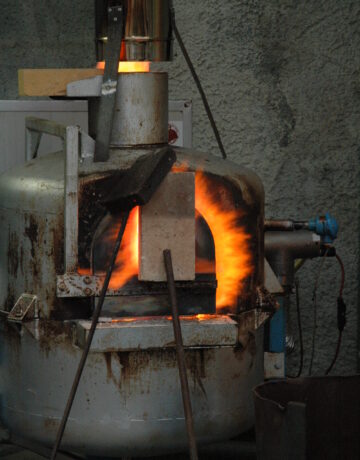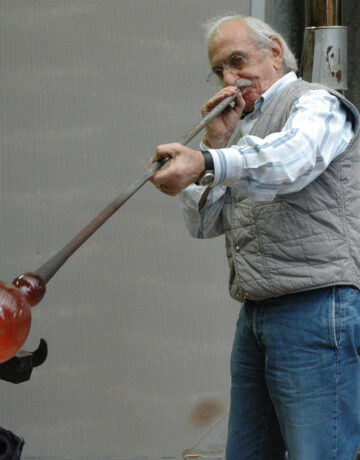Glass Art Museum: The Furnaces of Villa Rosa
 Thanks to the contribution of the De Mari Foundation, in the garden of Villa Rosa there are two small furnaces used for demonstrations during certain period of the year to support the Museum activity. They were lit for the first time on Christmas night in 2006, in memory of the 150th anniversary foundation of S.A.V. – Società Artistico Vetraria (Artistic Glassmaking Society) and became the fulcrum and beating heart of the Museum during the Altare Glass Fest, a festival organized annually in July. On this occasion the furnaces host master glassmakers of great fame, both nationally and internationally, for demonstrations open to the public.
Thanks to the contribution of the De Mari Foundation, in the garden of Villa Rosa there are two small furnaces used for demonstrations during certain period of the year to support the Museum activity. They were lit for the first time on Christmas night in 2006, in memory of the 150th anniversary foundation of S.A.V. – Società Artistico Vetraria (Artistic Glassmaking Society) and became the fulcrum and beating heart of the Museum during the Altare Glass Fest, a festival organized annually in July. On this occasion the furnaces host master glassmakers of great fame, both nationally and internationally, for demonstrations open to the public.
The furnaces are also turned on for the production of new prototypes intended for two annual events of the Museum: “Altare Vetro Design” and “Altare Vetro Arte”. These events are focused on bringing the designer or artist into synergy and collaboration with the master glassmaker. These moments of sharing lead to two exhibitions – respectively in the autumn and spring – capable of telling not only the planning and operational period but also the most recent production of the invited designer or artist.
The furnaces are also lit in November, on San Martino day (11 November), the date which in past centuries stated the beginning of the glassmakers’ working period which ended on 24 June, the San Giovanni day.
To stay informed about the days when the furnaces are lit, we recommend consulting the Museum’s website.
In memory of the life linked to the work in the furnace during the activity of the S.A.V., we propose a short text written by the Master Glassmaker Gino Bormioli, present in the catalogue of one of his exhibitions in 2012.
Glass furnaces, human hives
 Once the S.A.V. furnaces were authentic human hives. Many glassmakers worked around them, distributed in the various “squares”: each square was made up of six to twelve glassmakers.
Once the S.A.V. furnaces were authentic human hives. Many glassmakers worked around them, distributed in the various “squares”: each square was made up of six to twelve glassmakers.
The friendship and knowledge generated by long cohabitation and the constraint of operating in small spaces, encouraged participation, within the limits of decency, in the events of everyone’s life, from the amorous ones to the sporting ones, with the resulting often choral, cheerful and ironic teasing.
Despite the intensity of the work, the glassmakers, who were united by many cultural and sporting interests, conversed pleasantly. It was a way of escaping from work that was often very hard. The sporting topics were, first and foremost, hunting, football, skiing and mountaineering while the cultural ones focused on reading, theatre and music.
In the post-war period, we young people had become passionate about jazz, scandalizing the elderly who preferred symphonic and opera music.
Many glassmakers played an instrument in the City Band or in village music clubs: they defined jazz as the music of savages.
Since it was not possible to be absent from the workplace, as it was often a chain job, the figure of the “water carrier”(acquaiolo) was established: he was often an invalid worker, who, equipped with a can of fresh water and two glasses, would periodically offer the glassmakers a drink. On hot summer days, when the water carrier was late in making his rounds, the thirstiest of the glassmakers began to call out loudly: “Water carrier! Bring me some water (in po deva-in local dialect) please!”
The average culture of the glassmakers was a good level, the result of personal studies enriched by the experiences acquired during professional migrations to art cities, where we had the opportunity to attend prose and opera theatres.
Interest in mythology, history and literature, influenced the names that glassmakers gave to their children. Some were often heavy, demanding and burdensome, such as Josaphat, Agamemnon, Napoleon and many others.
Nicknames deriving from the dialect names of birds and due to the passion already mentioned for hunting migratory game, were also widely used, such as Blackbird, Magpie, Schiz.
The introduction of automatic machines to produce glassware has ousted glassmakers and glass factory today are a noisy and deserted place.
Bibliography:
Michela Murialdo, Le attività del Museo oggi, in Villa Rosa – Museo dell’Arte Vetraria Altarese (The activities of the Museum today, in Villa Rosa – Glass Art Museum of Altare), edited by Valentina Fiore, guide of the Liguria Regional Museums Directorate, Sagep editor, 2023, pp. 56-58
Gino Bormioli, Le fornaci da vetro, alveari umani, in Da Bergeggi ad Altare Percorsi di vetro (The glass furnaces, human hives, from From Bergeggi to Altare – Glass paths) by the master glassmaker Gino Bormioli, Ingraph Srl, 2012, pp. 18-19
